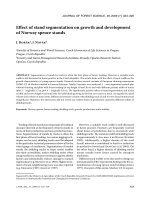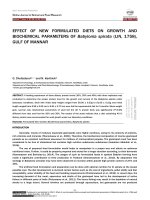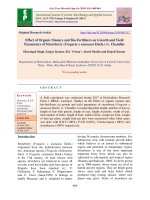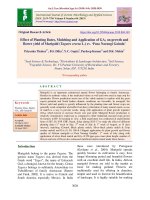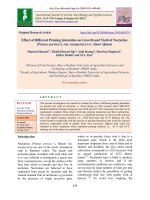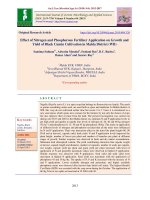Effect of temperature on growth and development of Thrips tabaci Lindeman in BT cotton
Bạn đang xem bản rút gọn của tài liệu. Xem và tải ngay bản đầy đủ của tài liệu tại đây (172.21 KB, 8 trang )
Int.J.Curr.Microbiol.App.Sci (2017) 6(5): 2553-2560
International Journal of Current Microbiology and Applied Sciences
ISSN: 2319-7706 Volume 6 Number 5 (2017) pp. 2553-2560
Journal homepage:
Original Research Article
/>
Effect of Temperature on Growth and Development of
Thrips tabaci Lindeman in BT Cotton
Simranjit Kaur, Jagdev Singh Kular and Ravinder Singh Chandi*
Department of Entomology, Punjab Agricultural University, Ludhiana, Punjab, India
*Corresponding author
ABSTRACT
Keywords
Cotton,
Growth index,
survival,
temperature,
Thrips tabaci.
Article Info
Accepted:
25 April 2017
Available Online:
10 May 2017
The effect of temperature on growth and development of Thrips tabaci Lindeman
was studied on Bt cotton at different constant temperature (25, 30 and 35°C) and
60 per cent relative humidity. Among all the three constant temperatures,
significantly the lowest duration (days) of incubation period (2.39), 1st instar
(2.29) and 2nd instar (3.03) nymphs, total nymphal period (5.10), pre-pupal period
(1.28), pupal period (1.85), total development period (10.00), adult longevity
(8.21) and total life cycle (18.13) were observed at 35°C, and these were highest
(4.58, 4.23, 5.78, 9.93, 2.12, 3.21 and 19.56, 22.19 and 41.72, respectively) at
25°C. Maximum fecundity-cum-viability (21.70 nymphs/female) and nymphal
survival (78%) were observed at 25°C, respectively and these were the minimum
at 35°C i.e. 7.80 nymphs per female and 34 per cent, respectively. Maximum
growth index was observed at 30°C and it was minimum at 35°C i.e. 7.92 and
6.70, respectively. It can be concluded that with the increase in temperature from
25 to 35°C there was significant decrease in the duration of various developmental
parameters, adult life parameters, total life cycle and per cent survival of T. tabaci.
Optimum temperature for the growth of T. tabaci is 30°C as growth index was
maximum at this temperature.
Introduction
Cotton fibre is an important raw material to
the textile industries and plays a key role in
national economy in terms of employment
generation and foreign exchange. India ranks
first in area and fourth in production on global
basis. In India, cotton was grown on an area
of 12.66 million ha with the production of
40.00 million bales and average lint yield of
537 kg/ha during 2014-15. In Punjab, it was
cultivated on an area of 0.45 million ha with
total production of 1.4 million bales and
average lint yield of 570 kg per ha during
2014-2015 (Anonymous, 2015). Despite the
large area, the productivity in India is very
low. One of the major constraints responsible
for the lower production of cotton is direct
damage caused by vast array of insect pests.
The extent of losses caused by sucking pests,
bollworms and both sucking pests as well as
bollworms have been recorded up to 12, 44
and 52 per cent, respectively on hirsutum
cotton (Dhawan et al., 1988). With the
introduction of Bt cotton, use of broad
spectrum insecticides have been reduced to a
2553
Int.J.Curr.Microbiol.App.Sci (2017) 6(5): 2553-2560
greater extent. As a result of this, non-target
insect pests with piercing-sucking mouth parts
such as leaf bugs, whiteflies, thrips, spider
mites and aphids cause serious damage to the
cotton crop (Xu et al., 2008).
Thrips tabaci Lindeman (Thysanoptera:
Thripidae) is the emerging pest of cotton crop
under Punjab conditions. This pest has the
potential to cause yield reduction of about 30
to 50 per cent (Cook et al., 2011). Thrips are
deleterious during high temperature and
scanty rainfall (Vennila et al., 2007). The
total variability in thrips populations in crops
is determined by the natural growth of
population and the influence of weather on
activity and rate of multiplication (Kirk,
1997).
Weather
variables
including
temperature, relative humidity and rainfall
have been reported as important factors that
significantly
affect
thrips
population
(Waiganjo et al., 2008). In addition to their
effect on thrips activity, temperature and
relative humidity further influence the
intrinsic rate of natural increase of thrips
(Murai, 2000). A basic understanding of the
relationship of these factors with thrips
population is important in developing an
integrated control strategy for thrips in cotton
and in determining the potential pest control
needs for a given climatic trend. The
objective of the present study was to study
various biological parameters of T. tabaci
under
different
constant
temperature
conditions.
Materials and Methods
Development of T. tabaci under different
combinations of temperature was studied in
the plant growth chamber installed at
Entomological Research Farm, Department of
Entomology, Punjab Agricultural University,
Ludhiana. Biology of thrips was studied at
three constant temperatures i.e. 25, 30 and
35oC and 60 per cent relative humidity.
Incubation period was studied by releasing
ten newly emerged females from leaf cage
made on potted cotton plants placed in growth
chamber at specific constant temperature.
These females were released singly on each of
ten potted cotton plants for oviposition. Serial
transfers of these females were made daily for
seven consecutive days. The time between the
release of the female and appearance of the
nymphs was considered as incubation period.
Nymphs were observed daily to note the
change of instar. This process was done till
pre-pupal stage. The interval between two
moultings was taken as duration of nymphal
instar and the period between the time of
release of a freshly hatched nymph and
change into pre-pupal stage was taken as the
total nymphal period. Pre-pupae were
observed daily to note the change into pupal
stage. When the second stage nymphs show
sluggish movement, it was considered as
beginning of pre-pupal stage. The colour of
the pre-pupa was somewhat white-yellowish
in colour and that of pupa was dark brownish
in colours. The pupa when completely
formed, the antennae folded back over the
head and wing pads were well developed.
Both the stages showed slight movement,
when they were disturbed. The newly
emerged adults from last experiment were
transferred to new leaf cage made on potted
cotton plants. The potted cotton plants were
kept under observation daily for the
emergence of the nymphs and survival of the
adults. The nymphs from each female were
counted and removed daily at the time of
observation. The total number of nymphs
emerged from one female represented the
fecundity-cum-viability of the female. The
female longevity was taken as the period from
the adult emergence till the death. The
survival percentage was calculated from the
number of adults developed from the number
of nymphs released. It was calculated by
using following formula:
2554
Int.J.Curr.Microbiol.App.Sci (2017) 6(5): 2553-2560
The means and standard error of means of
different
biological
parameters
were
calculated. Data were statistically analyzed
with analysis of variance (ANOVA) in
completely randomized design. The different
means were separated by critical difference
(CD) at p = 0.05 (Gomez and Gomez, 1984).
Results and Discussion
Biological parameters of T. tabaci under
various constant temperatures at 60 per
cent relative humidity
Incubation period
The laboratory studies conducted during 2014
revealed that there was significant difference
between the incubation periods of T. tabaci at
different constant temperature conditions. It
was significantly shortest at 35°C and highest
at 25°C. It varied from 4 to 5 days at 25°C, 3
to 4 days at 30°C and 2 to 3 days at 35°C,
respectively. The mean incubation period at
different
constant
temperatures
was
4.58±0.04, 3.18±0.04 and 2.39±0.04 days at
25, 30 and 35°C and 60 per cent relative
humidity. It is evident from the studies that
there was decrease in the incubation period
with increase in the temperature from 25 to
35°C (Table 1).
Nymphal development
The difference in nymphal instars period of T.
tabaci among different constant temperatures
was significant. The nymphal duration of first
instar was significantly shortest at 35°C
followed by 30°C and it was longest at 25°C.
The nymphal duration of first instar varied
from 2 to 3 days with a mean value of
2.29±0.05 days, 3 to 4 days with a mean value
of 3.63±0.04 days and 4 to 5 days with a
mean value of 4.23±0.02 days at 35, 30 and
25°C, respectively. There was decrease in
nymphal period of first instar with increase in
temperature from 25 to 35°C (Table 1).
The nymphal duration of second in star of T.
tabaci was significantly shortest at 35°C
followed by 30°C and significantly longest
duration of second instar nymph was
observed at 25°C. The nymphal duration of
second instar varied from 2 to 4 days with a
mean value of 3.03±0.06 days at 35°C, 4 to 5
days with a mean value of 4.37±0.03 days at
30°C and 5 to 6 days with a mean value of
5.78±0.03 days at 25°C (Table 1).
There was significant difference between total
nymphal periods of T. tabaci at all the
constant temperatures i.e. 25, 30 and 35°C
(Table 1). Total nymphal period was
significantly minimum at 35°C followed by
30°C and significantly maximum total
nymphal duration was observed at 25°C.
Total nymphal period at 35°C was 5.10±0.08
days (4 to 7 days) followed by 30°C which
ranged from 7 to 9 days with a mean value of
7.96±0.06 days and 9 to 11 days with a mean
value of 9.93±0.05 days at 25°C.
Pre-pupal and pupal development
Difference in pre-pupal period under various
constant temperatures and 60 per cent relative
humidity was significant (Table 1).
Significantly maximum pre-pupal period was
recorded at 25°C which varied from 2 to 3
days with a mean value of 2.12±0.03 days,
followed by 30°C which ranged from 1 to 2
days with a mean value of 1.52±0.03 days.
Significantly minimum pre-pupal period was
observed at 35°C with a mean value of
1.28±0.06 days (1-2 days). It is evident from
the studies that with the increase in constant
temperature there was decrease in pre-pupal
period. Difference in pupal period of T. tabaci
under various constant temperatures at 60 per
cent relative humidity on Bt cotton hybrid,
2555
Int.J.Curr.Microbiol.App.Sci (2017) 6(5): 2553-2560
RCH 650 was also significant. The maximum
pupal period of 3 to 4 days was recorded at
constant temperature of 25°C with a mean
value of 3.21±0.03 days and significantly
minimum pupal period ranged from 1 to 3
days with a mean value of 1.85±0.09 days at
35°C. Pupal period at 30°C was 2 to 3 days
with a mean value of 2.32±0.03 days. Pupal
period decreased when the constant
temperature increased from 25°C to 35°C
(Table 1).
Total development period
Total development period of T. tabaci was
significantly different at all three constant
temperatures i.e. 25, 30 and 35°C.
Significantly minimum duration of total
development period was observed at 35°C
with a mean value of 10.00±0.13 days ranging
from 8 to 12 days followed by 30°C with a
mean value of 14.43±0.10 days and
significantly maximum duration was observed
at 25°C which varied from 18 to 23 days with
a mean value of 19.56±0.11 days (Table 1). It
is evident from the study that with the
increase in temperature there was decrease in
total development period of T. tabaci.
Adult longevity
There was significant difference in adult
longevity of T. tabaci at different constant
temperatures on Bt cotton hybrid, RCH 650
BGII. The experiment conducted revealed
that female longevity was significantly
highest i.e. 17-26 days with a mean value of
22.19±0.16 days at constant temperature of
25°C. At temperature 30°C it ranged from 1521 days with mean value of 17.13±0.26 days.
Female longevity was significantly shortest
i.e. 8.21±0.16 days with a range of 6-11 days
at 35°C. There was decrease in the female
longevity with increase in the constant
temperature from 25 to 35°C (Table 2).
Fecundity-cum-viability
The fecundity-cum-viability of T. tabaci was
found to differ significantly on different
constant temperatures at 60 per cent relative
humidity. It varied from 18 to 25 nymphs per
female at 25°C, 12 to 17 nymphs per female
at 30°C and 5 to 9 nymphs per female at
35°C, respectively. Fecundity-cum-viability
was significantly highest with a mean value of
21.70±0.94 nymphs per female at 25°C
followed by 14.60±0.58 nymphs per female at
30°C. At 35°C fecundiy-cum-viability was
significantly lowest with a mean value of
7.80±0.42 nymphs per female. So, from these
findings we can conclude that with the
increase in temperature there was decrease in
fecundity-cum-viability (Table 2).
Total life cycle
Total life cycle of T. tabaci i.e. incubation
period, 1st instar nymph, 2nd instar nymph,
pre-pupa, pupa and female longevity was
recorded at different constant temperatures
with 60 per cent relative humidity on Bt
cotton hybrid, RCH 650 (BGII) (Plate 2). A
significant difference between total life cycle
at different constant temperature was
observed. Significantly minimum duration of
total life cycle with mean value of 18.13±0.27
days ranging from 14 to 22 days was recorded
at constant temperature of 35°C. Significantly
maximum duration was observed at constant
temperature of 25°C followed by 30°C i.e.
41.72±0.20 days and 31.55±0.32 days,
respectively. There was decrease in total life
cycle with increase in constant temperature
(Table 2).
Survival and growth index
The survival of nymphs was significantly
highest at 25°C constant temperature on
cotton which ranges from 70 to 90 per cent
with a mean value of 78.00±2.00 per cent and
it decreased to 63 per cent with a range of 50.
2556
Int.J.Curr.Microbiol.App.Sci (2017) 6(5): 2553-2560
to 80 per cent and 34.00±1.63 per cent at
30°C and at 35°C, respectively. It is evident
from the studies that with increase in
temperature from 25 to 35°C there was
decrease in per cent survival of nymphs
(Table 3).
Growth index of T. tabaci under various
constant temperatures and 60 per cent relative
humidity was significantly highest at 30°C
with a mean value of 7.92±0.37 which was at
par with growth index at 25°C with a mean
value of 7.85±0.20. Significantly lowest value
of growth index was observed at 35°C with a
mean value of 6.70±0.39 (Table 3). So, on the
basis of growth index it may be concluded
that 30°C was the optimum constant
temperature with 60 per cent relative
humidity for growth and development of T.
Tabaci
Table.3 Survival and growth index of T. tabaci on Bt cotton under various constant
Temperatures at 60 per cent relative humidity
Number
Number
Temperature
of
of
adults
(oC)
nymphs
developed
released
25
100
78
30
100
63
35
100
34
Nymphal survival
(%)*
Mean±SE
Growth
index
Range Mean±SE Range (Mean±SE)
78.00±2.00
(62.23)
63.00±3.00
(52.67)
34.00±1.63
(35.61)
(4.24)
CD (p =0.05)
Total nymphal
duration (days)
70-90
9.93±0.05
9-11
7.85±0.20
50-80
7.96±0.06
7-9
7.92±0.37
30-40
5.10±0.08
4-7
6.70±0.39
0.18
0.96
*Figures in parentheses are arc sine transformed values
Table.1 Developmental period of T. tabaci on Bt cotton under various constant
Temperatures at 60 per cent relative humidity
Temp-
Incubation
erature
period (days)
(oC)
Nymphal period (days)
I instar
II instar
Total
Pre-pupal period
Pupal period
(days)
(days)
Total
development
period (days)
Mean±SE Range Mean±SE Range Mean±SE Range Mean±SE Range Mean±SE Range Mean±SE Range Mean±SE Range
25
4.58±0.04
4-5
4.23±0.02
4-5
5.78±0.03
5-6
9.93±0.05 9-11 2.12±0.03
2-3
3.21±0.03
3-4
19.56±0.11 18-23
30
3.18±0.04
3-4
3.63±0.04
3-4
4.37±0.03
4-5
7.96±0.06
7-9
1.52±0.03
1-2
2.32±0.03
2-3
14.43±0.10 13-17
35
2.39±0.04
2-3
2.29±0.05
2-3
3.03±0.06
2-4
5.10±0.08
4-7
1.28±0.06
1-2
1.85±0.09
1-3
10.00±0.13 8-12
CD
(p=0.05)
0.11
0.11
0.12
0.18
Mean of ten replications; 10 individuals in each replication
2557
0.12
0.17
0.33
Int.J.Curr.Microbiol.App.Sci (2017) 6(5): 2553-2560
Table.2 Adult life parameters and total life cycle of T. tabaci on Bt cotton under various constant
temperatures at 60 per cent relative humidity
Fecundity-cumviability per female
(number)*
Mean±SE Range
21.70±0.94
18-25
(4.76)
14.60±0.58
12-17
(3.94)
7.80±0.42
5-9
(2.96)
(0.24)
Adult longevity
(days)
Temperature
(oC)
Mean±SE
Range
25
22.19±0.16
17-26
30
17.13±0.26
15-21
35
8.21±0.16
6-11
CD (p =0.05)
0.58
Total life cycle (days)
Mean±SE
Range
41.72±0.20
35-49
31.55±0.32
28-38
18.13±0.27
14-22
0.78
Mean of ten replications; 10 individuals in each replication
*Figures in parentheses are the means of √n+1 transformation
Incubation period
Our findings are in agreement with the study
of Kumar (2013) who reported that incubation
period of thrips on cotton was 2-4 days with a
mean value of 2.67±0.33 days when the mean
temperature was 34.17±0.43°C and relative
humidity was 46.10 per cent. Our results are
in close proximity with the findings of van
Rijn et al., (1995) who reported that the
incubation period was 3.92±0.32 days at 25°C
on cucumber. Fekrat et al., (2009) who
conducted their study at 25°C and 50 per cent
RH reported that the egg period of thrips
varied from 3.5 to 6.5 days with a mean value
of 4.97±0.07 days and 3.5 to 6 days with a
mean value of 4.63±0.09 days on onion in the
Khorasan Razavi and Golestan populations,
respectively and 4 to 6 days with mean value
of 5.11±0.07 days on tabacco in the
Mazandaran population. Lall and Singh
(1968) revealed that on onion it was 6.0 days
at fluctuating temperature conditions with
23.4°C average temperature and 54.4 per cent
average relative humidity and 4.8 at 30.8°C
average temperature and 47.6 per cent
average relative humidity, respectively.
Nymphal development
Our results are in close proximity with the
findings of Kumar (2013) who reported that
duration of first instar nymph varied from 2 to
3 days with a mean value of 2.50±0.22 days,
second instar nymph was of 3 to 5 days with a
mean value of 3.83±0.31 days and total
nymphal period varied from 5 to 7 days with a
mean value of 6.33±0.33 days, respectively
on cotton plant when the average temperature
was 34.17°C and relative humidity was 46 per
cent. In contrast to our findings Murai (2000)
repoted that first instar nymph and second
instar was of 2.38±0.54 and 2.87±0.57 days,
respectively at 25°C and 1.85±0.17 and
1.89±0.46 days, respectively at 30°C on
pollen and honey solution. Van Rijn et al.,
(1995) revealed that the first instar nymphal
period was 2.13±0.45 days and second instar
nymphal period was 3.17±0.45 days at 25°C
on cucumber. The difference in the period
may be due to difference in temperature and
host species involved.
Pre-pupal and pupal period
Our results corroborate the finding of Kumar
(2013) who reported that on cotton plant the
pre-pupal period of T. tabaci was of 1 to 2
days with a mean value of 1.33±0.21 days and
pupal period was of 1 to 3 days with a mean
value of 1.83±0.31days, respectively when the
average temperature was 34.17°C and relative
humidity was 46 per cent.
2558
Int.J.Curr.Microbiol.App.Sci (2017) 6(5): 2553-2560
Pre-pupal period varied from 1 to 2 days with
mean value of 1.67±0.21days and pupal period
varied from 2 to 3 day with a mean value of
2.67±0.21 days. Lall and Singh (1968) recorded
the pre-pupal and pupal period of 1.40 days and
2.40 days, respectively at 30.8°C on onion.
Similarly, Salas (1994) recorded that pre-pupal
and pupal period of T. tabaci was 1.17 and 2.4
days, respectively at 32°C and 60 per cent
relative humidity.
Total development period
Our results are in close corroboration with the
findings of Salas (1994) who reported that
thrips take 12.03 days from egg to adult at a
temperature of 32°C and 60 per cent relative
humidity on onion. In contrast to our findings
van Rijn et al., (1995) reported that that the
development period from egg to adult stage was
12.90±0.89 during their comparative study on
cucumber at 25°C.
Adult longevity
At fluctuating temperature , Kumar (2013)
reported female longevity of 12 to 24 days with
a mean value of 18.69±1.67 days on cotton
when the average temperature was
34.17±0.43 C
̊ and relative humidity was 46.10
per cent. Our results are in line with the findings
of Murai (2000) who reported that female
longevity was 25±10.2 at constant temperature
of 25°C and 12.8±4.6 days at constant
temperature of 30°C on pollen and honey
solution. Our results are also in close proximity
with the study of Salas (1994) who reported that
at 32°C temperature and 60 per cent relative
humidity, the longevity of thrips female was
21.5±3.69 days on onion. Salmasi et al., (2003)
found that the females lived for 16.15 days on
onion at 27°C. However, van Rijn et al., (1995)
found that at similar constant temperature
conditions i.e. 25°C females lived for 11.9 days
on cucumber that is lower than our results. This
difference in longevity of adult may be due to
the difference in crop species involved and
difference in environmental conditions.
Fecundity-cum-viability
Our results are in close proximity with the
findings of Fekrat et al.,(2009) who conducted
their study at 25°C, 50 per cent relative
humidity and reported that the total fecundity
varied from 12 to 41 with a mean value of
29.50±2.24 and 8 to 45 with a mean value of
27.71±2.83 on onion in the Khorasan Razavi
and Golestan populations, respectively and 11
to 35 with mean value of 26.35±1.93 on tabacco
in the Mazandaran population. Van Rijn et al.,
(1995) found that each female of T. tabaci laid
27.5 eggs on cucumber at 25°C. Whereas,
Murai (2000) revealed that total number of eggs
per female was 165±84.8 at constant
temperature of 25°C and 62.6±35.9 at constant
temperature of 30°C on pollen and honey
solution. Salas (1994) reported the fecundity of
thrips was 37 eggs per female and fertility was
62.28 per cent on onion at 32°C temperature
and 60 per cent relative humidity. The
difference in the values of fecundity may be due
difference in host species and due to difference
in environmental conditions.
Total life cycle
Our results are not in accordance with the
findings of Kumar (2013) who reported that the
total life cycle of thrips was 30.86±3.25 days at
34.17°C and 46.10 per cent relative humidity.
The difference in findings may be due
difference in environmental conditions.
Survival and growth index
Our results are in partial agreement with Fathi
et al., (2011) who reported that there was 40 to
90 per cent survival of nymphs on different
canola cultivars at 25°C. Murai (2000) reported
67.5 per cent survival both at 25 and 30°C on
pollen and honey solution. Our findings are not
in line with Kumar (2013) who revealed that at
average temperature of 34.17°C, there was 75
per cent survival and at average temperature of
31.43°C, per cent survival of nymphs was 89
per cent on cotton plant. The difference in
observations may be due to difference in
environmental conditions.
2559
Int.J.Curr.Microbiol.App.Sci (2017) 6(5): 2553-2560
References
Anonymous. 2015. Area, production and
productivity of cotton in different states in
India, http//: indiastat.com.
Cook, D., Herbert, A., Akin, A.D.S. and Reed,
J. 2011. Biology, crop injury and
management of thrips (Thysanoptera:
Thripidae) infesting cotton seedlings in
the United States. J. Integrated Pest
Management, 2: 1-9.
Dhawan, A.K., Sidhu, A.S. and Simwat, G.S.
1988. Assessment of avoidable loss in
cotton due to sucking pests and
bollworms. Indian J. Agric. Sci., 58: 29092.
Fathi, S.A.A., Gholami, F., Ganbalani, G.N. and
Mohiseni, A. 2011. Life history
parameters
of
Thrips
tabaci
(Thysanoptera:
Thripidae) on six
commercial cultivars of canola. Appl. Ent.
Zool., 46: 505-10.
Fekrat, L., Shishehbor, P., Manzari, S. and
Soleiman, N.E. 2009. Comparative
development, reproduction and life table
parameters of three population of Thrips
tabaci (Thysanoptera: Thripidae) on
onion and tobacco. J. Ent. Soc. Iran, 29:
11-23.
Gomez, A.K. and Gomez, A.A. 1984. Statistical
Procedures for Agricultural Research.
John Wiley and Sons, New York, USA.
Pp. 8-29.
Kirk, W.D.J. 1997. Distribution, abundance and
population dynamics. In: Thrips as Crop
Pests. (Eds.) T. Lewis. CAB International,
New York. Pp. 217-58.
Kumar, A. 2013. Biology of cotton thrips,
Thrips tabaci Lindeman (Thysanoptera:
Thripidae) on cotton (Gossypium spp.).
M. Sc. Thesis, Punjab Agricultural
University, Ludhiana, India.
Lall, B.S. and Singh, L.M. 1968. Biology and
control of the onion thrips in India. J.
Econ. Ent. 61: 76-79.
Murai, T. 2000. Effect of temperature on
development and reproduction of the
onion thrips, Thrips tabaci Lindeman
(Thysanoptera: Thripidae), on pollen and
honey solution. Appl. Ent. Zool., 35: 499504.
Salas, J. 1994. Biology and life habits of the
onion thrips (Thrips tabaci Lindeman).
Acta Hort., 58: 383-87.
Salmasi, M.H.Z., Hejazi, M. J. and Rahnemon,
A.A. 2003. Investigating of the life cycle
of onion thrips, Thrips tabaci Lind. In
insectarium. J. Agric. Sci., 13: 91-100.
Van Rijn, P.C.J., Mollema, C. and SteenhuisBroers, G.M. 1995. Comparative life
history
studies
of
Frankliniella
occidentalis
and
Thrips
tabaci
(Thysanoptera: Thripidae) on cucumber.
Bull. Ent. Res., 85: 285-97.
Vennila, S., Biradar, V.K., Sabesh, M. and
Bambawale, O.M. 2007. Know your
cotton insect pest thrips. Crop Prot.,
Folder series: 3.
Waiganjo, M.M., Gitonga, L.M. and Mueke,
J.M. 2008. Effects of weather on thrips
population dynamics and its implications
on the thrips pest management. Afr. J.
Hort. Sci., 1: 82-90.
Xu, W.H., Liu, B., Wang, R.M., Zheng, Y.P.,
Zhang, Y. and Li, X.G. 2008. Effects of
transgenic Bt cotton on insect community
in cotton fields of coastal agricultural area
of Jiangsu province. J. Ecol. Rural.
Envir., 24: 32-38.
How to cite this article:
Simranjit Kaur, Jagdev Singh Kular and Ravinder Singh Chandi. 2017. Effect of temperature on
growth and development of Thrips tabaci Lindeman in Bt cotton. Int.J.Curr.Microbiol.App.Sci.
6(5): 2553-2560. doi: />
2560
